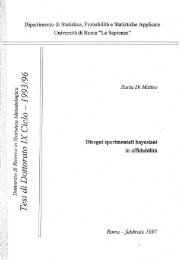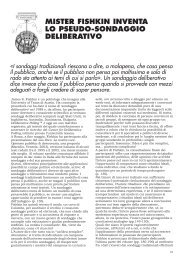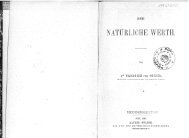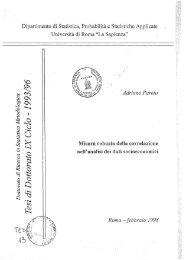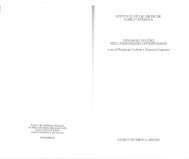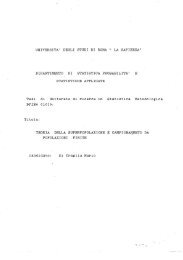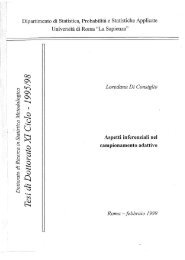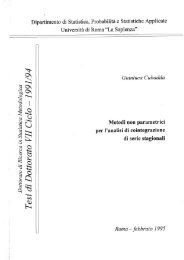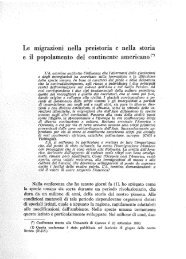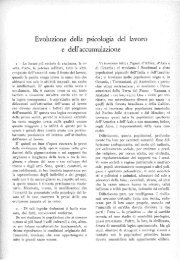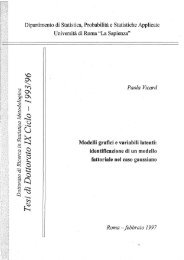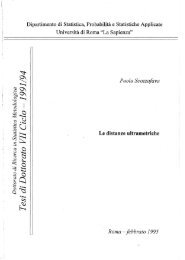Random Processes in Hyperbolic Spaces Hyperbolic Brownian ...
Random Processes in Hyperbolic Spaces Hyperbolic Brownian ...
Random Processes in Hyperbolic Spaces Hyperbolic Brownian ...
You also want an ePaper? Increase the reach of your titles
YUMPU automatically turns print PDFs into web optimized ePapers that Google loves.
37 <strong>Hyperbolic</strong> <strong>Brownian</strong> Motion<br />
(x, y) ∈ H 2 may be realized as the solution of the stochastic differential equations<br />
⎧<br />
⎨dX(t)<br />
= Y (t)dB1(t) − νY (t)dt,<br />
⎩dY<br />
(t) = Y (t)dB2(t) − µ − 1<br />
<br />
Y (t)dt,<br />
where B1(t) and B2(t) are two <strong>in</strong>dependent one-dimensional <strong>Brownian</strong> motions. Z(t) is represented<br />
as follows ⎧<br />
⎨X(t)<br />
= x + y<br />
⎩<br />
t<br />
0 exp{Bµ 2 (s)} dBν 1 (s),<br />
Y (t) = y exp{B µ<br />
2 (t)},<br />
where B ν 1 (t) = B1(t)−νt and B µ<br />
2 (t) = B2(t)−µt. S<strong>in</strong>ce µ is assumed to be positive, Y (t) converges<br />
to 0 as t tends to ∞. It is possible to show that the distribution of the horizontal component X(t)<br />
converges weakly as t tends to <strong>in</strong>f<strong>in</strong>ity to a given limit<strong>in</strong>g distribution.<br />
Let ha = {z ∈ H2 : Im{z} = a}, with 0 ≤ a < y, be the horocycle through ∞. If a = 0 we<br />
have that h0 is the boundary of the hyperbolic half plane H2. The hitt<strong>in</strong>g distribution on ha, with<br />
a > 0, of the diffusion process associated to L is given by the law of the random variable<br />
τa<br />
Xτa = x + y exp{B<br />
0<br />
µ<br />
2 (s)} dBν 1 (s)<br />
where τa = <strong>in</strong>f{t ≥ 0 : Y (t) = a} is the first hitt<strong>in</strong>g time on ha. With a slight abuse of term<strong>in</strong>ology<br />
the law of the random variable<br />
is the hitt<strong>in</strong>g distribution on h0.<br />
Hitt<strong>in</strong>g distribution on h0<br />
X∞ = x + y<br />
∞<br />
0<br />
exp{B µ<br />
2 (s)} dBν 1 (s)<br />
Let pz(ξ) be the density of the hitt<strong>in</strong>g distribution on h0 for the process associated to the operator<br />
L and start<strong>in</strong>g at z = (x, y). We po<strong>in</strong>t out that pz(ξ) is the Poisson kernel of L <strong>in</strong> the doma<strong>in</strong> H 2<br />
and satisfies the follow<strong>in</strong>g conditions:<br />
⎧<br />
Lpz(ξ) = 0, ∀ξ ∈ h0,<br />
⎪⎨ pz(ξ) > 0, ∀ξ ∈ h0,<br />
∞<br />
−∞<br />
⎪⎩<br />
pz(ξ)dξ = 1,<br />
limy→0 + pz(ξ) = 0, if ξ = x.<br />
S<strong>in</strong>ce L is <strong>in</strong>variant under the action of the map z → az + b then so is pz(ξ)dξ on R. That is<br />
pz(ξ) dξ = paz+b(aξ + b) d(aξ + b) = a paz+b(aξ + b) dξ.<br />
Sett<strong>in</strong>g a = 1 x<br />
y , b = − y and f(x) = pi(x) we have<br />
pz(ξ) = px+iy(ξ) = 1<br />
y pi<br />
<br />
ξ − x<br />
y<br />
2<br />
= 1<br />
y f<br />
<br />
ξ − x<br />
y<br />
(3.28)<br />
(3.29)



